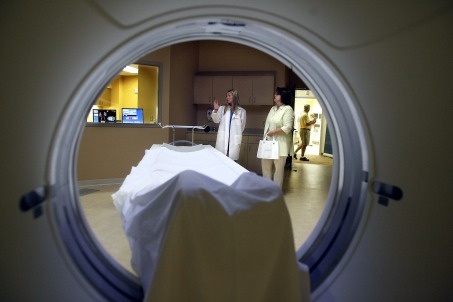Diagnosing cancer

Diagnosing cancer is the procedures and tests that determine whether cancer is present. The diagnostic journey often begins with an unusual finding on a screening procedure, such as a MAMMOGRAM or PROSTATE SPECIFIC ANTIGEN (PSA) BLOOD test, or diagnostic procedure done for another purpose such as an X-RAY or a complete blood count (CBC). Sometimes the person identifies symptoms, such as the presence of a lump or rectal bleeding.
The initial doctor’s evaluation includes a thorough ROUTINE MEDICAL EXAMINATION with specific focus on the abnormal findings; comprehensive PERSONAL HEALTH HISTORY; and appropriate diagnostic tests, which may include any combination of blood tests, X-rays, COMPUTED TOMOGRAPHY (CT) SCAN, POSITRON EMISSION TOMOGRAPHY (PET) SCAN, MAGNETIC RESONANCE IMAGING (MRI), ULTRASOUND, and biopsy.
Biopsy provides the definitive diagnosis for cancer, giving the pathologist the opportunity to examine tissue structure and cell composition. Depending on the location, size, and characteristics of a tumor, the doctor may remove a small sample of tissue or remove the entire tumor. Common methods for sampling tumors include
- fine-needle aspiration, in which the doctor inserts a small needle into the tumor to withdraw a sample of fluid and cells
- core-needle biopsy, in which the doctor inserts a larger needle into the tumor to extract a core of solid tissue
- ENDOSCOPY, in which the doctor inserts an endoscope into the body through a natural opening to examine suspicious tissues and remove samples
- incisional biopsy, in which the surgeon removes a portion of the tumor to obtain a representative tissue sample
- excisional biopsy, in which the surgeon removes the entire tumor
The pathologist then determines, from the diagnostic tests, imaging procedures, and biopsy findings, the cancer’s stage and grade-assessments of how extensive the presence of the cancer in the body and how aggressive the growth of the cancer cells. Though most cancers fit within the standard parameters of STAGING AND GRADING OF CANCER, some do not. The doctor may then present the circumstances and diagnostic findings to a review panel of physician specialists, often called the “tumor board,” for additional input and assessment. All of these evaluations then help guide the CANCER TREATMENT OPTIONS AND DECISIONS.
See also CANCER PREVENTION; COLONOSCOPY; SURGERY BENEFIT AND RISK ASSESSMENT; SURGERY FOR CANCER.
Open discussion on the topic Diagnosing cancer The procedures and tests
Similar interests
- Nuovi Casino
- Casinos Not On Gamstop
- UK Casinos Not On Gamstop
- Casinos Not On Gamstop
- UK Casinos Not On Gamstop
- Casino Non Aams Italia
- Slot Sites Not On Gamstop
- Meilleur Casino En Ligne
- Non Gamstop Casino Sites UK
- Meilleur Casino En Ligne
- Casino En Ligne France
- Best Non Gamstop Casinos
- Casinos Not On Gamstop
- UK Casino Not On Gamstop
- Casinos Not Signed Up To Gamstop
- Best Slot Sites UK
- Non Gamstop Casino Sites UK
- Online Casinos Nederland
- Online Casinos Nederland
- Casinos Not On Gamstop
- Best New Uk Casinos Not On Gamstop